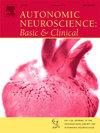Microneedle-assisted iontophoretic transdermal administration of adrenergic antagonists does not modulate palmar sweating induced by static exercise in healthy young adults
IF 3.3
4区 医学
Q2 NEUROSCIENCES
引用次数: 0
Abstract
Palmar sweating is primarily evoked by psychological and physical (e.g., exercise) stress, while the peripheral control of this response remains uncertain. We investigated whether the transdermal administration of adrenergic antagonists modulates palmar sweating induced by isometric knee extension (IKE) exercise. In a climate chamber (28 °C and 40 % relative humidity), 15 healthy young adult males completed IKE exercises at maximal (5 s maximum voluntary contraction, MVC) and submaximal (50 % MVC to exhaustion) effort, before and after the transdermal iontophoretic administration of bretylium (noradrenergic sympathetic nerve inhibitor), terazosin (α-adrenergic receptor antagonist), propranolol (β-adrenergic receptor antagonist), or NaCl (control) to the palm pretreated with solid microneedles to enhance skin permeability. The efficacy of terazosin and propranolol on the palm was assessed by administering α- and β-adrenergic agonists (phenylephrine and salbutamol combined with aminophylline, respectively) in follow-up studies, whereas bretylium efficacy was verified by evaluating cold-induced palmar cutaneous vasoconstriction. Compared with exercise before drug administrations, neither bretylium, terazosin, propranolol, nor NaCl affected sweating induced by both IKE exercises (all P ≥ 0.600, interaction and treatment effect). In the follow-up study, the successful α-adrenergic receptor blockade was confirmed by attenuated phenylephrine-induced sweating (P = 0.001). Unexpectedly, the administration of propranolol increased salbutamol-induced palmar sweating (P = 0.008), leaving the efficacy of β-adrenergic receptor blockade uncertain. The bretylium administration effectively abolished cold-induced cutaneous vasoconstriction (P = 0.006). In conclusion, this study demonstrates that transdermal administration of bretylium, terazosin, and propranolol does not alter palmar sweating induced by IKE exercise, implying the absence of adrenergic modulation.
微针辅助离子透皮给药肾上腺素能拮抗剂不会调节健康年轻人静态运动引起的手掌出汗
手掌出汗主要是由心理和生理(如运动)压力引起的,而这种反应的外周控制仍然不确定。我们研究了肾上腺素能拮抗剂的经皮给药是否会调节等长膝关节伸展(IKE)运动引起的手掌出汗。在气候室(28°C和40%相对湿度)中,15名健康的年轻成年男性在经皮离子吸氧给药bretylium(去甲肾上腺素能交感神经抑制剂)、terazosin (α-肾上腺素能受体拮抗剂)、propranolol (β-肾上腺素能受体拮抗剂)之前和之后,以最大(5 s最大自愿收缩,MVC)和次最大(50% MVC至精疲力竭)的努力完成IKE运动。或NaCl(对照)到手掌,用固体微针预处理,以增强皮肤的渗透性。在后续研究中,泰拉唑嗪和心得安对手掌的疗效通过给予α-肾上腺素激动剂和β-肾上腺素激动剂(分别为苯肾上腺素和沙丁胺醇联合氨茶碱)来评估,而布雷特利姆的疗效通过评估冷诱导的手掌皮肤血管收缩来验证。与给药前运动相比,布雷利姆、特拉唑嗪、心得安、NaCl对两种IKE运动引起的出汗均无影响(P均≥0.600、相互作用及治疗效果)。在随访研究中,α-肾上腺素能受体阻断成功,苯肾上腺素引起的出汗减弱(P = 0.001)。出乎意料的是,普萘洛尔增加了沙丁胺醇引起的手掌出汗(P = 0.008),使β-肾上腺素能受体阻断的效果不确定。溴代溴铵能有效消除冷致皮肤血管收缩(P = 0.006)。总之,本研究表明,经皮给药布雷利姆、特拉唑嗪和心得安不会改变IKE运动引起的手掌出汗,这意味着不存在肾上腺素能调节。
本文章由计算机程序翻译,如有差异,请以英文原文为准。
求助全文
约1分钟内获得全文
求助全文
来源期刊
CiteScore
5.80
自引率
7.40%
发文量
83
审稿时长
66 days
期刊介绍:
This is an international journal with broad coverage of all aspects of the autonomic nervous system in man and animals. The main areas of interest include the innervation of blood vessels and viscera, autonomic ganglia, efferent and afferent autonomic pathways, and autonomic nuclei and pathways in the central nervous system.
The Editors will consider papers that deal with any aspect of the autonomic nervous system, including structure, physiology, pharmacology, biochemistry, development, evolution, ageing, behavioural aspects, integrative role and influence on emotional and physical states of the body. Interdisciplinary studies will be encouraged. Studies dealing with human pathology will be also welcome.

 求助内容:
求助内容: 应助结果提醒方式:
应助结果提醒方式:


